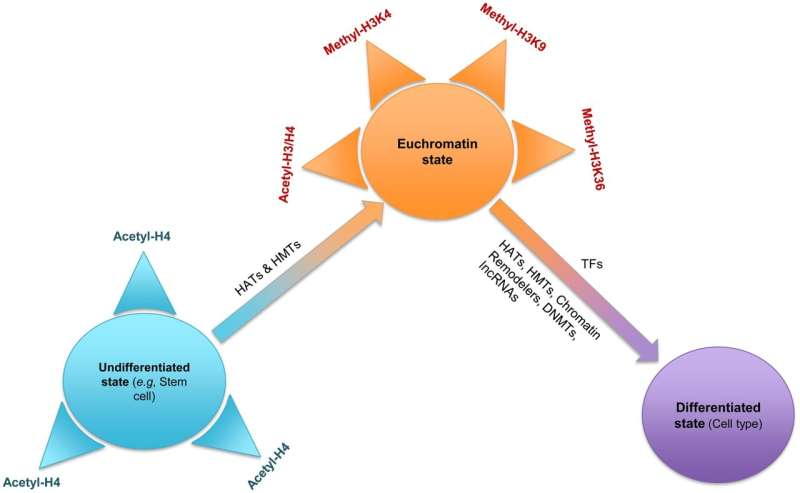This article has been reviewed according to Science X's editorial process and policies. Editors have highlighted the following attributes while ensuring the content's credibility:
fact-checked
proofread
Researchers discuss expanding role of epigenetics in human health and disease

Epigenetics, a term coined by Conrad H. Waddington in the early 1940s, originally described the complex molecular pathways that govern how a genotype manifests as a phenotype. Over time, this definition has evolved to focus on heritable changes in gene activity that occur without altering the DNA sequence itself.
Unlike genetic mutations, which are often permanent, epigenetic modifications are reversible and can significantly influence gene expression, playing a crucial role in both normal development and the pathogenesis of various diseases.
The development of epigenetics has been marked by significant milestones. Waddington and others laid the foundation for understanding how environmental factors can influence gene function. Key discoveries, such as the identification of DNA methylation and the elucidation of nucleosome structure, have been pivotal in advancing the field. Waddington's epigenetic landscape metaphorically illustrated how cells differentiate into various types during development, influenced by internal and external factors.
Epigenetic regulation involves several key mechanisms, including DNA methylation, histone modification, and RNA-mediated processes. DNA methylation, particularly at CpG islands, is a well-studied mechanism where methyl groups are added to cytosine nucleotides, often leading to transcriptional repression when these regions are hypermethylated. This process is crucial for normal development and cellular differentiation, but aberrant methylation patterns can contribute to disease states.
Histone modifications, such as acetylation, methylation, and phosphorylation, also play critical roles in regulating gene expression. These modifications can either activate or repress transcription depending on the specific chemical changes and the context within the chromatin structure. The discovery of the "histone code" has highlighted the complexity and specificity of these regulatory mechanisms.
Non-coding RNAs, including microRNAs and long non-coding RNAs, have emerged as important regulators of gene expression. These RNAs can modulate transcriptional and post-transcriptional processes, adding another layer of control over the epigenetic landscape.
Epigenetic mechanisms are particularly important during embryonic development, where they help guide the differentiation of pluripotent stem cells into various specialized cell types. The uterine environment plays a critical role in shaping the epigenome of the developing embryo, with lasting effects on the health and disease susceptibility of the offspring. Environmental factors, such as diet, stress, and exposure to toxins, can induce epigenetic changes that not only affect the individual but can also have transgenerational effects.
A striking example of epigenetic regulation is X-chromosome inactivation (XCI) in females, which ensures dosage compensation between sexes. XCI exemplifies how DNA methylation and other epigenetic marks can lead to stable, heritable gene silencing.
The role of epigenetics in disease is profound and multifaceted. Dysregulation of epigenetic mechanisms has been implicated in a wide range of conditions, including cancer, cardiovascular diseases, neurological disorders, and metabolic syndromes. For instance, hypermethylation of tumor suppressor genes is a common feature in many cancers, leading to their silencing and contributing to uncontrolled cell proliferation.
Neurodegenerative diseases, such as Alzheimer's and Parkinson's, have also been linked to epigenetic changes. Abnormal histone modifications and DNA methylation patterns can affect genes involved in neuronal function and survival, highlighting the potential for epigenetic therapies in these conditions.
Advancements in technology have greatly enhanced our ability to study the epigenome. Techniques such as chromatin immunoprecipitation followed by sequencing (ChIP-seq), transposase-accessible chromatin using sequencing (ATAC-seq), and various forms of RNA sequencing have provided detailed insights into the complex interplay of epigenetic marks.
CRISPR/Cas9 technology has been adapted to target and modify specific epigenetic marks, offering a powerful tool for functional studies and potential therapeutic applications. Additionally, single-cell epigenomics is emerging as a crucial approach to understanding cellular heterogeneity and the dynamics of epigenetic regulation.
Epigenetic therapies are an exciting frontier in medicine. Drugs targeting DNA methyltransferases (DNMTs) and histone deacetylases (HDACs) are already in clinical use for certain cancers. Ongoing research aims to develop more specific and effective epigenetic drugs with fewer side effects.
Epigenetics represents a crucial interface between our genetic blueprint and environmental influences, profoundly affecting human health and disease. Continued research in this field holds the promise of novel diagnostic tools and therapeutic strategies, potentially transforming our approach to a wide range of medical conditions.
The research is published in the journal Exploratory Research and Hypothesis in Medicine.
More information: Swarup K. Chakrabarti et al, Expanding Role of Epigenetics in Human Health and Disease, Exploratory Research and Hypothesis in Medicine (2024). DOI: 10.14218/ERHM.2023.00086


















